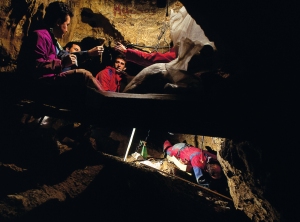Environment Institute 2014 Highlights
It has been a busy year for the Environment Institute with some fantastic research moments!
Our research on the evolution of birds from the t-rex in collaboration with the South Australian Museum was named as one of Science magazines breakthroughs of the year 2014.
[caption id="" align="alignnone" width="300" caption="At the Sima de los Huesos. Credit: Science Mag/JAVIER TRUEBA/MADRID SCIENTIFIC FILMS"] [/caption]
[/caption]
2014 Highlights include:
Read more of our top stories for 2014:
TED Speaker and “Drones Ecologist” Lian Pin Koh joins the Environment Institute
New clues to evolution dug up from world’s largest human fossil collection
How do you get to work? Our researchers abseil. Stories from the Natural Trap Cave, Wyoming.
“Elephant in the room” no more, models show even one-child policy is no quick fix to population growth
“Alien” fossils found on Kangaroo Island have been identified as human relatives
ARC grant success - five Discovery and two DECRA's awarded to EI researchers
Our research on the evolution of birds from the t-rex in collaboration with the South Australian Museum was named as one of Science magazines breakthroughs of the year 2014.
[caption id="" align="alignnone" width="300" caption="At the Sima de los Huesos. Credit: Science Mag/JAVIER TRUEBA/MADRID SCIENTIFIC FILMS"]
 [/caption]
[/caption]2014 Highlights include:
- Outstanding results from the 2014 Australian Research Council funding rounds including, an Australian Laureate Fellowship awarded to Professor Alan Cooper. In addition, three Future Fellowships, two DECRA’s, five Discovery, and three Linkage grants were awarded.
- Continued delivery of high impact research evidenced by three publications in both Nature and Science, and two each for Nature Climate Change and Proceedings Of The National Academy Of Sciences.
- 2014 Future Fellow Dr Lee Arnold was part of an international team that uncovered new clues to human evolution from the Sima de los Huesos (the pit of bones), an archaeological site with the most complete record of human fossils.
- The Environment Institute has recently approved the establishment of an Unmanned Research Aircraft Facility (URAF) under the directorship of Lian Pin Koh. Using innovative technology, the conservation drones will facilitate research to address biological conservation and land management problems that have traditionally been difficult to implement.
Read more of our top stories for 2014:
TED Speaker and “Drones Ecologist” Lian Pin Koh joins the Environment Institute
New clues to evolution dug up from world’s largest human fossil collection
How do you get to work? Our researchers abseil. Stories from the Natural Trap Cave, Wyoming.
“Elephant in the room” no more, models show even one-child policy is no quick fix to population growth
“Alien” fossils found on Kangaroo Island have been identified as human relatives
ARC grant success - five Discovery and two DECRA's awarded to EI researchers

Newsletter & social media
Join us for a sensational mix of news, events and research at the Environment Institute. Find out about new initiatives and share with your friends what's happening.
